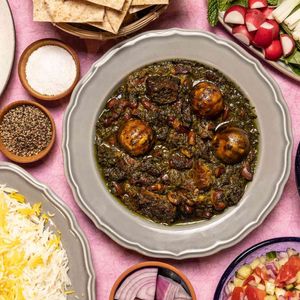Ingredients
Equipment
Method
- Rinse and soak kidney beans overnight or use a quick-soak method. Pierce dried limes several times with a sharp knife or fork to allow their flavor to release.
- Heat half the olive oil or ghee in a large Dutch oven or heavy-bottomed pot over medium-high heat. Season the meat chunks with salt and pepper, then brown thoroughly on all sides. Remove the seared meat and set aside.
- Reduce heat to medium, add the remaining olive oil or ghee to the pot. Sauté the diced onion until softened and lightly golden, about 8-10 minutes. Stir in the ground turmeric and cook for another minute until fragrant.
- Return the seared meat to the pot with the onions. Add the soaked (and drained) kidney beans and 6 cups of water or broth. Bring to a boil, then reduce heat to low, cover, and simmer for 1 hour.
- While the stew simmers, wash and thoroughly dry all fresh herbs (cilantro, parsley, Persian leeks/chives/scallions). Finely chop them.
- In a large skillet, heat a generous amount of oil (e.g., 1/4 cup) over medium heat. Add the chopped fresh herbs and cook, stirring frequently, for 25-30 minutes, or until they are very dark green, almost black, and significantly reduced in volume. Stir in the crushed dried fenugreek for the last 5 minutes of cooking.
- After the initial simmering, add the pierced dried limes to the Dutch oven. Stir in the intensely sautéed herb mixture.
- Continue to simmer the stew, covered, on low heat for another 2-3 hours, or until the meat is fork-tender and the flavors have deeply melded. Stir occasionally to prevent sticking.
- Taste the stew and adjust salt as needed. The flavors should be rich, savory, and distinctly tart from the limes.
- Ladle the Khoresh-e Ghormeh Sabzi into bowls, traditionally served warm with steamed basmati rice (chelo or polo).
Notes
For the dried limes (limoo amani), pierce them thoroughly to allow their tart essence to infuse the stew. The intense sautéing of the herbs is paramount; this process, known as 'sabzi gereftan,' deepens their flavor and color, but constant stirring is essential to prevent burning. Ensure your fenugreek is dried and crushed; its aroma is potent, and moderation is key to avoid bitterness. Achieving a rich, deeply browned crust on your lamb or beef prior to braising will build a robust flavor foundation (fond) for the stew. This dish truly thrives on a long, slow simmer, allowing the complex flavors to meld and the meat to become exceptionally tender.
